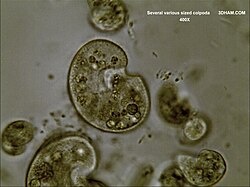General physiology; an outline of the science of life (1899) (14596394647)
Identifier: generalphysiolo00verw (find matches)
Title: General physiology; an outline of the science of life
Year: 1899 (1890s)
Authors: Verworn, Max, 1863-1921 Lee, Frederic S. (Frederic Schiller), 1859-1939, ed. and tr
Subjects: Physiology
Publisher: London, Macmillan and co., limited New York, The Macmillan company
Contributing Library: Columbia University Libraries
Digitizing Sponsor: Open Knowledge Commons
View Book Page: Book Viewer
About This Book: Catalog Entry
View All Images: All Images From Book
Click here to view book online to see this illustration in context in a browseable online version of this book.
Text Appearing Before Image:
th simple growth. AnAmoeba changes simply by increasing in mass and then dividing.The halves then grow again until they become so large that theyagain divide. The whole developmental cycle of Amoeba consistsin growth up to cell-division. We see, therefore, that growth and ELEMENTARY VITAL PHENOMENA 205 cell-division are the simplest elements that development demands ; in fact, in the whole living world there is no development withoutgrowth and cell-division. In all Protista that reproduce by spore-formation, there occurs a development expressing itself in com-plex changes of form. In this case the spores, which are totallyunlike the mother-cell, must pass through a series of changes ofform until they become like it. The development of the Protistahas been little studied. Nevertheless, Khumbler (88) hasfollowed completely and with great care that of the infusoriangenus Colpoda. Colpoda is a small bean-shaped infusorian, thesurface of whose whole body is ciliated (Fig. 84, A). In spore-
Text Appearing After Image:
Fig. S4.—Development of Colpoda cucullus. (After Rhumbler.) formation the body surrounds itself with a thick envelope orcyst (B), within which by giving off water the body constantlydiminishes its volume. Finally it extrudes all undigested food-particles and draws itself together into a ball (C), which loses itscilia and surrounds itself by a second smaller envelope (D). Thecontents of this second envelope (E) break up into single spores,which together with a remnant consisting of useless materialburst the capsule and freely wander out (E). From each spore (G)a new individual develops by the spore transforming itself into asmall amoeba-like being which creeps about, takes food, grows(H, J, K, L), develops a long flagellum with which it swims (31),and finally contracts into a small spherical cell (A7), which coversits surface with cilia (0), and by further growth gradually assumesthe form of a Colpoda (P, Q, P). Thus the developmental cycle iscompleted. 206 GENEHAL PHYSIOLOGY That wh
Note About Images
Relevante Bilder
Relevante Artikel
ColpodaColpoda ist eine Gattung von Wimpertierchen aus der Klasse Colpodea, deren Ordnung Colpodida und in dieser Ordnung in der Familie Colpodidae. Die Erstbeschreibung der Gattung Colpoda stammt vom dänischen Naturalisten Otto Friedrich Müller aus dem Jahr 1773. .. weiterlesen





















